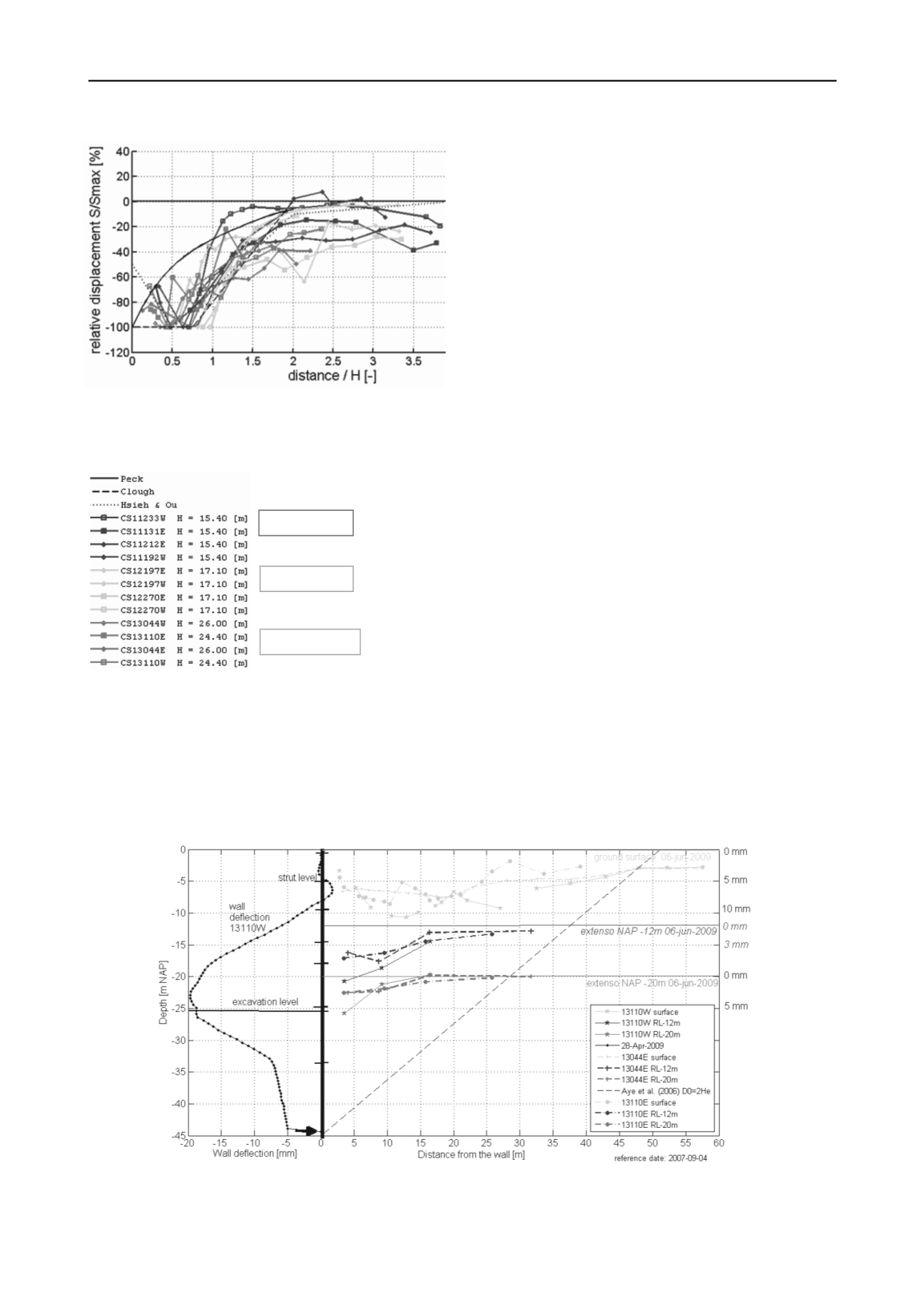
2782
Proceedings of the 18
th
International Conference on Soil Mechanics and Geotechnical Engineering, Paris 2013
2-3 times the excavated depth away from the wall. The shape
of the displacement fits the profile of Hshieh and Ou (1998)
best.
In all three of the Amsterdam cases, the largest effect on the
ground surface displacement can be attributed to the preliminary
activities, which include amongst others the diaphragm wall
construction, jet grout strut installation and construction of the
roof and took in total about 4 years. The actual excavation stage
caused only about 25-45% of the surface displacements, with
55-75% attributed to the preliminary activities. At larger
excavation depths the influence zone is significantly smaller
than 2 times the excavation depth.
5 ACKNOWLEDGEMENTS
Figure 7 Measured surface displacements normalized with excavation
depth H for three Amsterdam deep stations at the deepest excavation
level available
(2009-07-01), compared to settlement envelopes
proposed by Peck (1969), Clough and O’Rourke (1990) and Hsieh and
Ou (1998). With:
This research was performed in cooperation with the Dutch
Centre for Underground Construction (COB). The authors wish
to thank the city of Amsterdam for permission to use the data.
6 REFERENCES
Aye, Z.Z., Karki, D. and Schulz, C. (2006) Ground Movement
Prediction and Building Damage Risk-Assessment for the Deep
Excavations and Tunneling Works in Bangkok Subsoil.
International Symposium on Underground Excavation and
Tunnelling
, Bangkok, Thailand
Clough and O’Rourke (1990) Clough, G. W. and O. Rourke, T.D.
(1990). Construction induced movements of insitu walls.
ASCE
specialty Conference, ASCE Special Publication 25
.
Rokin
Hsieh, P. G. and Ou, C. Y. (1998) Shape of ground surface settlement
profiles caused by excavation,
Canadian Geotechnical Journal
,
Vol. 35, pp. 1004-1017.
Vijzelgracht
Fernie, R., Shaw, S. M, Dickson, R. A, St John, H. D, Kovacedic, N,
Bourne-Webb, P. and Potts, D. M. (2001). Movement and deep
basement provisions at Knightsbridge Crown Court, Harrods
, Int.
Conf. Response of Buildings to Excavation Induced Ground
Movements
. CIRIA, London..
Ceintuurbaan
5 CONCLUSIONS
The settlement measurements for the Amsterdam deep
excavations have been compared to several, mostly empirical,
relationships to determine the green field surface displacements
and displacements at depth.
Korff, M., Mair,R.J., Van Tol, A.F. and Kaalberg, F.J. (2011) Building
damage and repair due to leakage in a deep excavation.
Forensic
Engineering
Volume 164 (FE4), 165–177
It is concluded that the surface displacement behind the wall
is 0.3 – 1.0% of the excavation depth, if all construction works
are included. Surface displacements behind the wall can be
much larger than the wall deflections and become negligible at
de Nijs, R.E.P. & Buykx. S.M. (2010). Instrumentation and
Monitoring at Deep Excavation in Historic City of Amsterdam.
Design and Performance Analysis of Monitoring System at
Ceintuurbaan Station.
ITA 2010
. Vancouver
Peck, R. B. (1969) Deep excavations and tunneling in soft ground, . 7th
Int.Conf. Soil Mech. Fdn. Engrg, Mexico City
, Sociedad Mexicana
de Mecanica de Suelos, A.C.
Figure 8 Measured ground displacements at Ceintuurbaan Station (13044E, 13110E and 13110W). Influence zone as
described by Aye et al. (2006) but with D0=2He instead of 2.5He shown as diagonal line


